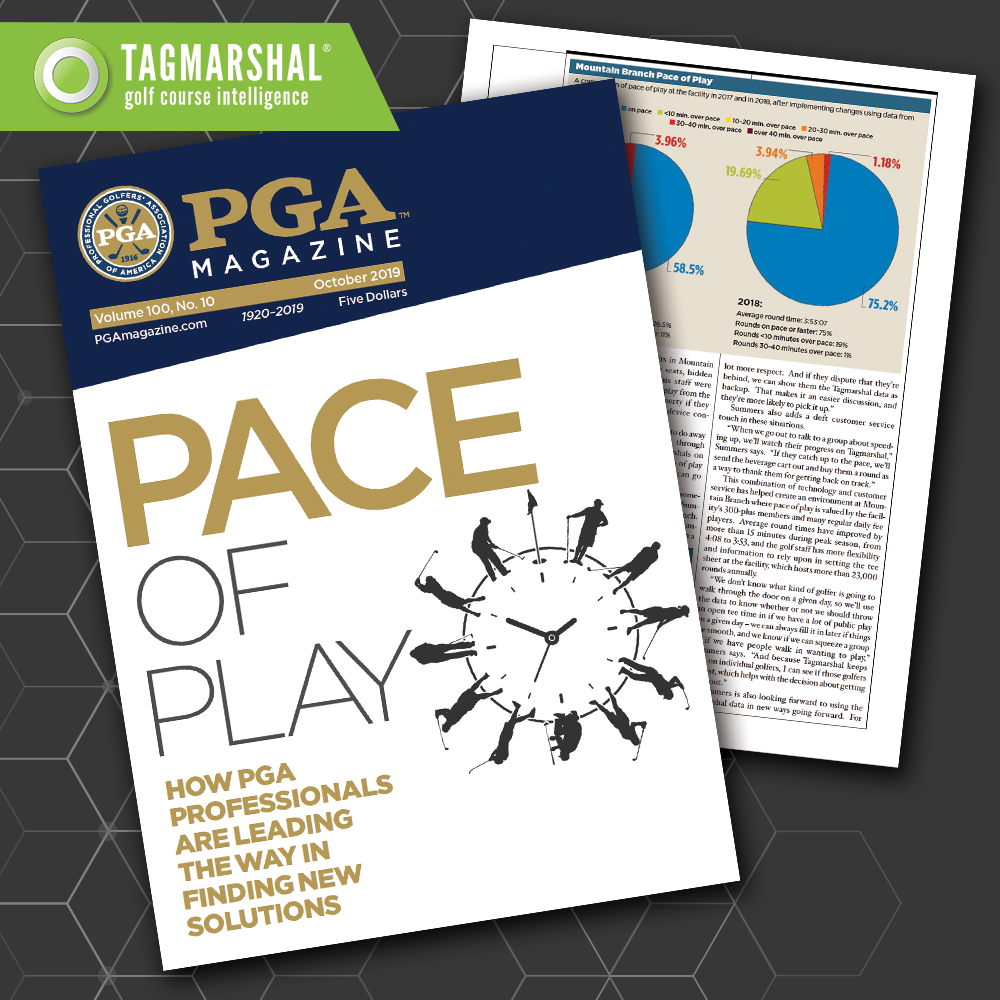NEWS
PGA Magazine: 11 takeaways on improving pace of play
PGA Magazine: 11 takeaways on improving pace of play
Find out how using technology, such as Tagmarshal’s golf course intelligence software, can help to improve the golfer experience, in PGA Magazine’s Pace of Play article.
Here are some of the key points PGA Professionals should know about strategies to improve pace of play at their facilities:
- Pace of play is one of the top three factors that influence how much customers enjoy their golf experience.
- Pace of play on the world’s professional tours is a hot topic, giving PGA Professionals a chance to start a conversation about pace with recreational golfers at their facilities.
- New technologies for tracking pace and location of golfers on the course are being leveraged for research and to create new strategies for improving pace.
- The USGA is conducting ongoing research into pace of play, and has invented specific statistics that help facilities measure Pace.
- According to research, the USGA believes that overall round time is not as important as maintaining a steady flow during the course of a round – golfers don’t like to wait to hit shots.
- Technology solutions from the USGA, and companies like Tagmarshal and FairwayIQ, can help facilities learn more about patterns, challenges and possible pace solutions.
- The ROI for pace of play technology solutions can include spending less money on payroll for rangers, which can be shifted to additional PGA Professionals, while improving the consumer experience.
- Using a pace of play solution that enables PGA Professionals to monitor pace from a smartphone or computer can allow a golf professional to handle difficult situations directly, instead of involving a ranger or other employee.
- Daily fee and resort courses can benefit from a pace of play solution that helps them pinpoint slow groups quickly before they cause a course-wide backup.
- Private clubs benefit from improved pace of play by increasing member satisfaction, which can lead to retention and even acquiring new members once a culture of improved pace is created.
- Facilities can also improve the experience for tournaments, leagues and events by recognizing bottlenecks on the course, and by aligning tee time intervals with data on realistic pace expectations.
Over the longer term, these companies can compile data from hundreds of rounds that can help identify root causes of slow play at a facility, and can lead to policies or practices that improve pace of play.
For example, data could show areas of the golf course where pace slows, giving the facility the chance to make layout or maintenance changes in the area. Or tracking groups of fast players on an uncrowded day could help establish what the fastest realistic time is for players to get around the course, which could lead to a change in tee time intervals.
The result of improved pace of play can be seen in increased engagement for golf facilities: More rounds played, more time spent at the range prior to a round or enjoying food & beverage afterward, or having more time on the tee sheet for events or junior golf programs. Slight data-based tweaks to the tee sheet can add thousands of dollars to the bottom line at some facilities.
National Golf Links of America Improved tournament pace of play by providing shuttle service to avoid a long walk around the water.
National Golf Links of America Improved tournament pace of play by providing shuttle service to avoid a long walk around the water.
“A lot of this isn’t possible without today’s technology – it empowers everything we’re looking at in pace of play,” Mingay says.
“The ability to visualize and analyze data on a large scale makes new strategies possible. To get data points from hundreds of rounds or thousands of golfers really helps move the needle in a way that anecdotal evidence simply can’t.”
The USGA is making pace of play a major focus, with the organization including pace-oriented changes in the new Rules of Golf that went into effect earlier this year, as well as hosting regular Golf Innovation Symposiums to share research and discuss new ideas for improving pace of play. The topic is also a key part of the USGA’s goal to improve golfer satisfaction by 20 percent while reducing the consumption of key resources by 25 percent before 2025.
To help golf facilities learn more about pace of play at their individual facilities, the USGA started a research program using GPS loggers at participating golf courses. To measure how golfers move around the course, and what causes backups, the USGA created a measurement called Cycle Time – essentially the amount of time it takes for one group to leave a green and for the next group to reach it – as well as a tool that helps calculate a reasonable target time for groups to play that course.
What the USGA found is that Cycle Time is an important variable in deciding tee time intervals.
Click here to find out how Tagmarshal’s Golf Course Intelligence Software improves the Golfer experience, by optimizing Pace of Play.
ABOUT TAGMARSHAL
Tagmarshal, the market leader in on-course optimization technology, provides courses with full, real-time operational oversight and reporting, giving golf operators the tools to manage pace and flow of play effectively, resulting in enhanced player experiences, increased efficiency through automation, and additional revenue generation.
Tagmarshal’s technology has collected over 1 billion data points from more than 50 million rounds of golf and has relationships with in excess of 500 partners, including Hazeltine, Whistling Straits, Baltusrol, Fieldstone, Bandon Dunes, Serenoa and Erin Hills.
Tagmarshal partners with several golf management groups, private, daily fee, public and resort courses, including 35 of the Top 100 US courses, as well as many $30-$50 green fee courses, which are seeing excellent results using the system.
 WATCH DEMO
WATCH DEMO